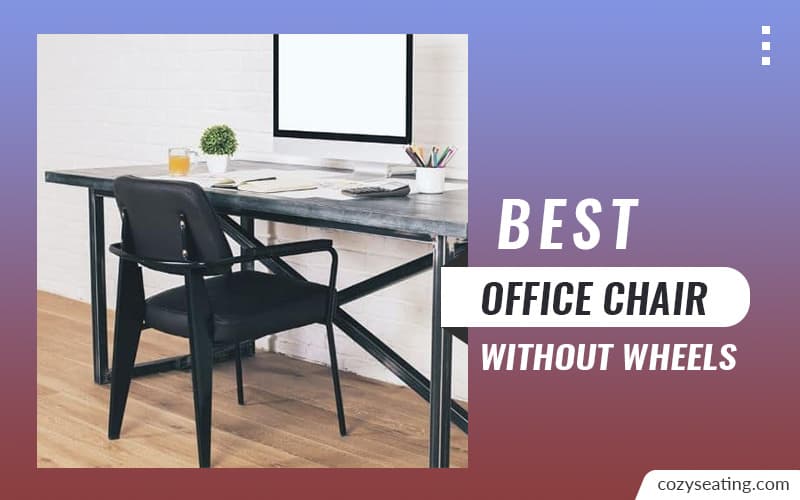
Disclosure: This site is reader-supported & contains affiliate links. We may earn a commission through products purchased using links on this page. Learn more

A lot goes into revamping the look of your office chairs, especially when sewing. There is a lot to do, from selecting suitable fabrics to measuring, cutting out the pieces, disassembling your chair, installing the covers, and putting back the chair.
This is an all-encompassing post that provides expert tips on how to cover an office chair without sewing.
You can reupholster a chair yourself if you have time and patience. If you aren’t a professional, you cover an office chair without sewing using pillowcases, covers or stapling. Moreover, you can make a slipcover for an office chair using fabric glue and get your chairs looking chic.
Table of Contents
How Do You Cover a Chair With Fabric Without Sewing?
There are several methods you can use to cover your office chair with the fabric without sewing. And amongst the simplest is using clothing.
Choose Your Clothing
The first step is selecting the clothing that works best for you. Many fabrics are suitable for this project, including cotton, polyester, satin, silk, rayon, and linen.
The main thing to remember when selecting which clothes to choose is that they should not have any holes or tears.
- Use Old T-Shirts
T-shirts are an excellent choice if you want to cover a home office chair. However, they may not look so professional or appealing in a public office.
To insert your old T-shirt, detach the backrest and the seat pan before sliding the t-shirt in place and reassembling your seat.
Also, you need to cut holes in a few places, like the gas cylinder socket. So, acquire some scissors.
- Use Old Sheets
Old bedsheets may do the trick too! They’re usually pretty sturdy and easy to find at thrift stores. When using sheets, measure your seat pan and backrest.
While measuring, provide an allowance of about three more inches to provide room for stapling the cut-outs onto your chair.
- Use Old Towels
A towel is soft enough to sit on yet durable enough to hold its shape. It may take more than one towel to cover your chair completely.
Remember to provide an allowance while measuring the towel pieces.
- Use Old Blankets
Blankets are another good option since they come in all kinds of sizes. Plus, they tend to be very thick and heavy, meaning they’d last longer than other materials.
- Use Old Curtains
Curtains are perfect for covering chairs because they’re typically made of sturdy canvases like denim. And unlike blankets, curtains aren’t going to fall apart after sitting on hard surfaces for a while.
- Use Old Tablecloths
Tablecloth liners are often used under dining room tables and kitchen countertops. These are generally thicker than regular tablecloths and therefore better suited for covering furniture.
- Use Old Pillows
Pillowcases are always handy to keep around the house. But they’re also handy for covering your chairs and couches. Slip the case onto the back of the chair.
Next, pull the sides together until they meet in the middle. Once done, tie the ends closed.
- Use Old Rugs
Rugs can double as covers for chairs. Moreover, you can use them to protect against spills while keeping the rug clean.
To create a new seat cushion, simply remove the backing, flip the rug upside down, lay it flat, and put the padding right where you wanted the cushions to go.
Office Chair Covers
You can buy office chair covers online or visit local retailers who sell these products. The best thing about buying office chair covers online is that there are many options available.
Also, when shopping online, you get to see exactly how each product looks before purchasing it.
To insert an office chair cover:
- Unzip the top flap
- Slide the cover over the chair
- Zip up the bottom flap
- Fold the edges inward
- Tie off the corners
Enjoy your newly covered chair!
How Do I Make a Slipcover for an Office Chair?
You can also make your office chair covers using fabric glue instead of stitching. To do this:
- Cut the fabric according to the size needed.
- Place glue side down on the wrong side of the fabric
- Press firmly with fingers or iron
- Remove excess glue from the surface by rubbing gently with a dry cloth
- Allow drying overnight
- Repeat steps 3-5 until the entire area has been coated with glue
- Apply tape to the underside of the fabric
- Position fabric on the desired spot
- Peel away paper backing
- Smooth out wrinkles
- Trim edges
- Attach ribbon ties
Can You Reupholster a Chair Without a Sewing Machine?
Reupholstering a chair without a sewing machine is possible. It’s simple, too.
Even so, there are several factors that determine whether you want to go ahead with a DIY project or hire professional upholsterers.
1. What Type of Material Should I Use?
The most important thing here is to decide whether you would rather buy ready-made cushions or improvise. There are many types of fabrics available today. Some of them require special skills to work with.
For example, if you choose cotton, you’ll need to know about weaving techniques. On the other hand, polyester requires no such knowledge.
Simply put, it depends entirely upon your budget and personal preferences.
2. Is Your Fabric Thick Enough?
Another factor to keep in mind is thickness. Most people think that thicker fabrics are more durable than thinner ones. That may not always be true.
Sometimes, thin fabrics are better because they allow air circulation. Also, remember that thick fabrics tend to absorb moisture faster. Therefore, you might find yourself having to replace your cushions sooner than expected.
3. Are You Ready to Spend Time & Money?
If you’re planning to use high-quality materials like leather, velvet, suede, silk, wool, and linen, then you’d have to spend some cash.
Again, even though you could save by buying cheap versions of those materials, the chances are that you wouldn’t end up happy with their performance.
As far as DIY projects are concerned, you shouldn’t expect much help from manufacturers. They usually provide instructions for making simple items like throw blankets. The same goes for chairs.
Sure, you can easily cover one with a sheet of plastic wrap. But why bother doing something that doesn’t add value to your life?
Instead, focus on creating unique designs and patterns. After all, isn’t that what makes office decorating fun?
4. Will You Be Able to Find a Good Match Between Materials & Design?
When working with professionals, you’ll often come across different styles and colors. While you can certainly try out new things, you’ll never truly understand how each material works until you’ve tried it first.
With DIY projects, however, you only have access to limited choices. Unless you already have experience with certain kinds of fabrics, you won’t experiment freely.
Can I Reupholster a Chair Myself?
Reupholstering a chair may seem easy enough, but if you’re not careful, you might damage your existing finish.
Before starting any project, always read through manufacturer’s guidelines carefully to know what steps need to be taken before proceeding further.
Also, take note of any special care instructions provided by the manufacturer. Once you decide whether you want to do the work yourself or hire someone else, here are some tips to keep in mind:
1. How Much Time Do You Have?
If you’re short on time, you probably shouldn’t attempt this task alone. Instead, look for a local upholstery shop that offers reupholstered items.
They will likely charge more than doing the job yourself, but their expertise could save you lots of money down the road.
2. Are There Any Special Tools Required?
Most people don’t realize just how many tools they need to complete a successful reupholstering project.
Even when not sewing, you still need other supplies like spray adhesive, stain repellent, paint brushes, sandpaper, and even a vacuum cleaner.
3. Will Your Project Be Done on Schedule?
When working with a professional, you won’t necessarily get a specific timeline. However, you should expect them to give you at least a rough estimate based on past projects.
Remember that every piece is different. So no matter how much planning goes into a particular project, things rarely go according to plan.
That being said, it’s important to remember that while you may think you’ve got plenty of time to spare, sometimes unexpected issues arise during the process.
So, if you want a quick job, then it may be better to choose a reputable company that knows what they’re doing.
Frequently Asked Questions
1. What Is the Easiest Way to Reupholster a Chair?
The easiest way to reupholster a chair is by using pillowcases or ready-made office chair covers. However, you may have to spend more than using old clothing if you don’t plan to sew these covers yourself.
2. Can I Reupholster Over Existing Fabric?
You can reupholster over existing fabric, and you may even significantly improve your seat’s comfort depending on the fabric thickness.
However, ensure the color underneath isn’t darker than your new cover if the new cover is a light fabric.
Conclusion
Using office chair covers isn’t only fun; it’ll help save money too. Besides, you aren’t sewing, which saves you the expertise and time needed.
So why wait? Start saving today with our best ways to cover office chairs without sewing!
Recommended Reading

10 Best White Office Chair You’ll Love to Buy in 2022
The best white office chair will elevate your office décor and offer optimal comfort. Our top chairs are durable, stylish, and comfortable.

How Long Does Office Chair Last?
The quality of your chair directly affects it’s durability. But today’s office chairs have compromised quality. So, how long does office chair last? Find out.

10 Best Office Chair Without Wheels to Buy in 2022
If you're looking for the best office chair without wheels, look no further. We have some of the best-rated chairs on Amazon you can select today.

Steelcase Series 1 Vs. Series 2 : Which Is the Better Option?
Steelcase Series 1 vs. Series 2! Explore our detailed comparison of the two ergonomic office chairs and choose the ideal one for a fantastic sitting experience.
